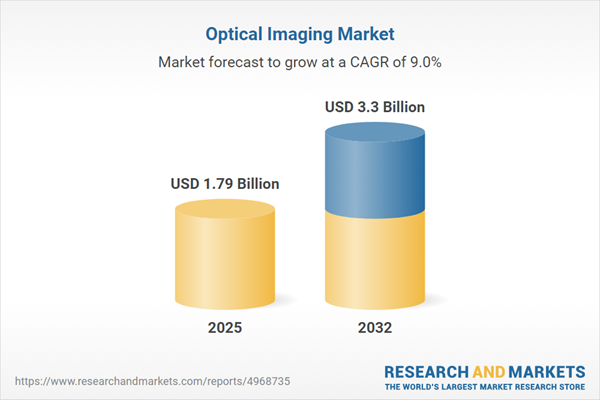Speak directly to the analyst to clarify any post sales queries you may have.
Optical imaging technologies are advancing rapidly, redefining research, diagnostics, and industrial quality management in global markets. Senior decision-makers need clarity on evolving dynamics and actionable insights to position their organizations for sustained opportunity within this sector.
Market Snapshot: Optical Imaging Market Size and Growth Prospects
The Optical Imaging Market grew from USD 1.66 billion in 2024 to USD 1.79 billion in 2025. It is expected to continue growing at a CAGR of 8.97%, reaching USD 3.30 billion by 2032. This robust expansion reflects the integration of precision imaging across healthcare, industrial, and research applications, with innovations addressing rising demands for noninvasive diagnostics, efficient quality control, and advanced materials analysis.
Scope & Segmentation of the Optical Imaging Market
This comprehensive report addresses major product offerings, technologies, applications, end users, regions, and leading companies influencing the optical imaging value chain.
- Product: Accessories (lenses, light sources, probes), devices (cameras, instruments), imaging systems (optical and spectral), and software (diagnostic, image analysis)
- Technology: Fluorescence imaging, optical coherence tomography (OCT), photoacoustic imaging, and spectroscopy
- Application: Industrial (nondestructive testing, quality control), medical diagnostics, research and development
- End-User: Aerospace & defense, automotive, electronics, healthcare
- Region: Americas (United States, Canada, Mexico, Brazil, Argentina, Chile, Colombia, Peru), Europe (United Kingdom, Germany, France, Russia, Italy, Spain, Netherlands, Sweden, Poland, Switzerland), Middle East (UAE, Saudi Arabia, Qatar, Turkey, Israel), Africa (South Africa, Nigeria, Egypt, Kenya), Asia-Pacific (China, India, Japan, Australia, South Korea, Indonesia, Thailand, Malaysia, Singapore, Taiwan)
- Companies: Abbott Laboratories, AG Optical Systems, Agfa-Gevaert N.V., Angstrom Sun Technologies, Inc., Bioptigen, Inc., Canon Inc., Carl Zeiss Meditec AG, Edmund Scientific Corporation, GeoTec, Inc., Hamamatsu Photonics K.K.
Key Takeaways: Strategic Insights for Decision-Makers
- Optical imaging advancements are increasingly integrating software and hardware, enabling more precise, real-time analysis across medical and industrial contexts.
- Collaborative R&D across academia and industry is accelerating commercialization of new imaging modalities and expanding the addressable market for specialized solutions.
- Demand for compact, energy-efficient, and eco-friendly components is shaping both product development and manufacturing strategies.
- Broader adoption in sectors like aerospace, automotive, and electronics reflects the technology’s versatile fit for noninvasive inspection and quality control requirements.
- Regional leadership shifts are influenced by policy incentives, infrastructure investments, and localized expertise, notably in Asia-Pacific manufacturing and European innovation hubs.
- Data security and interoperability standards are now primary considerations as imaging systems become increasingly cloud-enabled and integrated with enterprise platforms.
Tariff Impact: U.S. Trade Policy and the Supply Chain
The implementation of U.S. tariffs on essential optical imaging components in 2025 has prompted manufacturers to reevaluate sourcing, cost structures, and strategic partnerships. This shift encourages diversification of the supplier base and reinforces the need for supply chain agility, with companies prioritizing local and regional manufacturing alongside broader global procurement strategies to maintain operational continuity.
Research Methodology & Data Sources
Analysis is grounded in primary interviews with industry experts, including CTOs, researchers, and regulatory advisors. Extensive secondary research, peer-reviewed publications, and triangulation techniques validate market trends, technology adoption, and segment performance. Continuous expert feedback ensures empirical rigor and updates on evolving market dynamics.
Why This Report Matters
- Delivers a holistic view of optical imaging trends, actionable for strategic planning and investment prioritization.
- Equips leaders with segmentation, competitive landscape, and regulatory insights to respond proactively to industry shifts.
- Supports informed decision-making in resource allocation, market expansion, and technology adoption initiatives.
Conclusion
With significant transformations underway across technology, supply chains, and regional demand, the optical imaging market presents both complexity and opportunity. Leaders armed with the insights from this report are positioned to drive innovation, resilience, and growth across a rapidly evolving global environment.
Additional Product Information:
- Purchase of this report includes 1 year online access with quarterly updates.
- This report can be updated on request. Please contact our Customer Experience team using the Ask a Question widget on our website.
Table of Contents
3. Executive Summary
4. Market Overview
7. Cumulative Impact of Artificial Intelligence 2025
Companies Mentioned
The companies profiled in this Optical Imaging market report include:- Abott Laboratories
- AG Optical Systems
- Agfa-Gevaert N.V.
- Angstrom Sun Technologies, Inc.
- Bioptigen, Inc.
- Canon Inc.
- Carl Zeiss Meditec AG
- Edmund Scientific Corporation
- GeoTec, Inc.
- Hamamatsu Photonics K.K.
Table Information
| Report Attribute | Details |
|---|---|
| No. of Pages | 190 |
| Published | November 2025 |
| Forecast Period | 2025 - 2032 |
| Estimated Market Value ( USD | $ 1.79 Billion |
| Forecasted Market Value ( USD | $ 3.3 Billion |
| Compound Annual Growth Rate | 8.9% |
| Regions Covered | Global |
| No. of Companies Mentioned | 11 |









